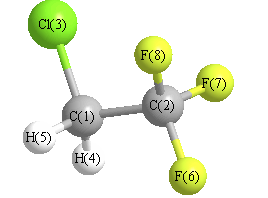Vibrational Frequencies calculated at HF/6-31G*
| Mode Number |
Symmetry |
Frequency
(cm-1) |
Scaled Frequency
(cm-1) |
IR Intensities
(km mol-1) |
Raman Act
(Å4/u) |
Dep P |
Dep U |
|---|
| 1 |
A' |
3308 |
2972 |
11.49 |
|
|
|
| 2 |
A' |
1625 |
1460 |
28.71 |
|
|
|
| 3 |
A' |
1523 |
1369 |
65.51 |
|
|
|
| 4 |
A' |
1435 |
1289 |
178.05 |
|
|
|
| 5 |
A' |
1333 |
1198 |
290.96 |
|
|
|
| 6 |
A' |
939 |
844 |
24.62 |
|
|
|
| 7 |
A' |
867 |
779 |
38.59 |
|
|
|
| 8 |
A' |
695 |
624 |
36.12 |
|
|
|
| 9 |
A' |
580 |
521 |
9.60 |
|
|
|
| 10 |
A' |
386 |
347 |
0.33 |
|
|
|
| 11 |
A' |
201 |
181 |
2.10 |
|
|
|
| 12 |
A" |
3376 |
3034 |
1.01 |
|
|
|
| 13 |
A" |
1475 |
1325 |
207.29 |
|
|
|
| 14 |
A" |
1262 |
1134 |
91.55 |
|
|
|
| 15 |
A" |
1015 |
912 |
9.18 |
|
|
|
| 16 |
A" |
579 |
521 |
3.41 |
|
|
|
| 17 |
A" |
379 |
341 |
1.19 |
|
|
|
| 18 |
A" |
108 |
97 |
4.03 |
|
|
|
Unscaled Zero Point Vibrational Energy (zpe) 10544.2 cm
-1
Scaled (by 0.8985) Zero Point Vibrational Energy (zpe) 9474.0 cm
-1
See section
III.C.1 List or set vibrational scaling factors
to change the scale factors used here.
See section
III.C.2
Calculate a vibrational scaling factor for a given set of molecules
to determine the least squares best scaling factor.
Charges, Dipole, Quadrupole and Polarizability
Charges from optimized geometry at HF/6-31G*
Charges (e)
| Number |
Element |
Mulliken |
CHELPG |
AIM |
ESP |
| 1 |
C |
-0.510 |
|
|
|
| 2 |
C |
1.100 |
|
|
|
| 3 |
Cl |
-0.039 |
|
|
|
| 4 |
H |
0.248 |
|
|
|
| 5 |
H |
0.248 |
|
|
|
| 6 |
F |
-0.360 |
|
|
|
| 7 |
F |
-0.344 |
|
|
|
| 8 |
F |
-0.344 |
|
|
|
Electric dipole moments
Electric dipole components in Debye
(What's a Debye? See section
VII.A.3)
| |
x |
y |
z |
Total |
| |
-1.199 |
1.653 |
0.000 |
2.042 |
| CHELPG |
|
|
|
|
| AIM |
|
|
|
|
| ESP |
|
|
|
|
Electric Quadrupole moment
Quadrupole components in D Å
| Primitive |
|---|
| | x | y | z |
|---|
| x |
-40.987 |
-2.826 |
0.000 |
| y |
-2.826 |
-39.836 |
0.000 |
| z |
0.000 |
0.000 |
-39.487 |
|
| Traceless |
|---|
| | x | y | z |
|---|
| x |
-1.325 |
-2.826 |
0.000 |
| y |
-2.826 |
0.400 |
0.000 |
| z |
0.000 |
0.000 |
0.925 |
|
| Polar |
|---|
| 3z2-r2 | 1.850 |
|---|
| x2-y2 | -1.150 |
|---|
| xy | -2.826 |
|---|
| xz | 0.000 |
|---|
| yz | 0.000 |
|---|
|
Polarizabilities
Components of the polarizability tensor.
Units are
Å
3 (Angstrom cubed)
Change units.
| |
x |
y |
z |
| x |
4.264 |
0.834 |
0.000 |
| y |
0.834 |
5.138 |
0.000 |
| z |
0.000 |
0.000 |
3.701 |
<r2> (average value of r
2) Å
2
| <r2> |
185.607 |
| (<r2>)1/2 |
13.624 |
